Towards the Development of an Integrated Sustainability and Resilience Benefits Assessment Framework of Urban Green Growth Interventions
Abstract
:1. Introduction
2. Methods
- Keywords: sustainability benefits, urban, sustainability assessment, impact assessment, resilience assessment;
- Research areas: sustainability studies, engineering, environmental assessment, decision science, economics, urban studies, geography, architecture, climate change mitigation, climate change adaptation, energy, buildings, water, transportation, solid waste management, ecosystem services;
- Date of publication: between 2005 and 2015;
- Publication language: English.
- City-wide sustainability assessments,
- Integrated sectoral sustainability assessments,
- Rating sustainability benefits assessment approaches,
- Climate project-based sustainability assessment methods and
- Sustainability assessments with resilience components.
3. Existing Sustainability Assessment Methodologies
3.1. City-Level Sustainability Assessment Methodologies
3.2. Integrated Sectoral Sustainability Benefit Assessment Approaches
3.3. Rating Sustainability Benefit Assessment Approaches
3.4. Climate Project-Based Sustainability Assessment Methods
3.5. Sustainability Assessments with Resilience Components
4. Main Issues to Consider When Developing an SRBA Methodology
4.1. Sustainability Dimensions and Resilience Coverage
4.2. Reference for Measuring Sustainability Benefits
- Baseline as a reference:
- Benchmark as a reference:
4.3. Multiple Levels of Sustainability and Resilience Benefits
4.4. Weighting
4.5. Trade-Offs between Categories of Benefits
4.6. Applicability and Adaptation Ability
4.7. Participation and Learning
4.8. Illustration and Communication of Results
5. Conceptual Framework
5.1. A Systems Thinking Approach
5.2. Different Types of Sustainability and Resilience Benefits
5.3. Sustainability and Resilience Benefits Categories
5.4. Different Levels of Sustainability and Resilience Benefits
6. Steps of the Proposed Srba Methodology
6.1. Identification of the Project and Its Main Characteristics
6.2. Identification of Expected Benefits
6.3. Identification of Indicators for Expected Sustainability Benefits
6.4. Development of the Baseline Scenario
- Spatial information refers to the features that have a spatial significance and can be geographically mapped, such as open spaces, surface water bodies, buildings, roads, topography, etc.
- Aspatial information refers to the datasets that are not spatial in nature, but are connected with the area of interest, such as household size, average household income, use of buildings (residential, commercial, institutional), property prices, etc.
6.5. Development of the Project Scenario
6.6. Estimation of the Difference between Baseline and Project Scenarios
6.7. Development of the Sustainability and Resilience Benefits Assessment Matrix
7. An Illustrative Example: Urban Forest in the City of Cali, Colombia
7.1. Identification of the Project and Its Main Characteristics
7.2. Identification of the Expected Impacts/Benefits
7.3. Identification of Indicators for Expected Sustainability Impacts/Benefits
7.4. Development of the Baseline Scenario
7.5. Development of the Project Scenario
7.6. Estimation of the Difference between Baseline and Project Scenarios
7.7. Development of the Sustainability and Resilience Benefits Assessment Matrix
8. Concluding Remarks
Acknowledgments
Author Contributions
Conflicts of Interest
Appendix A: SRBA Framework

Appendix B: Link of the SRBA Framework and Global SDGs

Appendix C: Urban Green Growth Interventions in Different Sectors
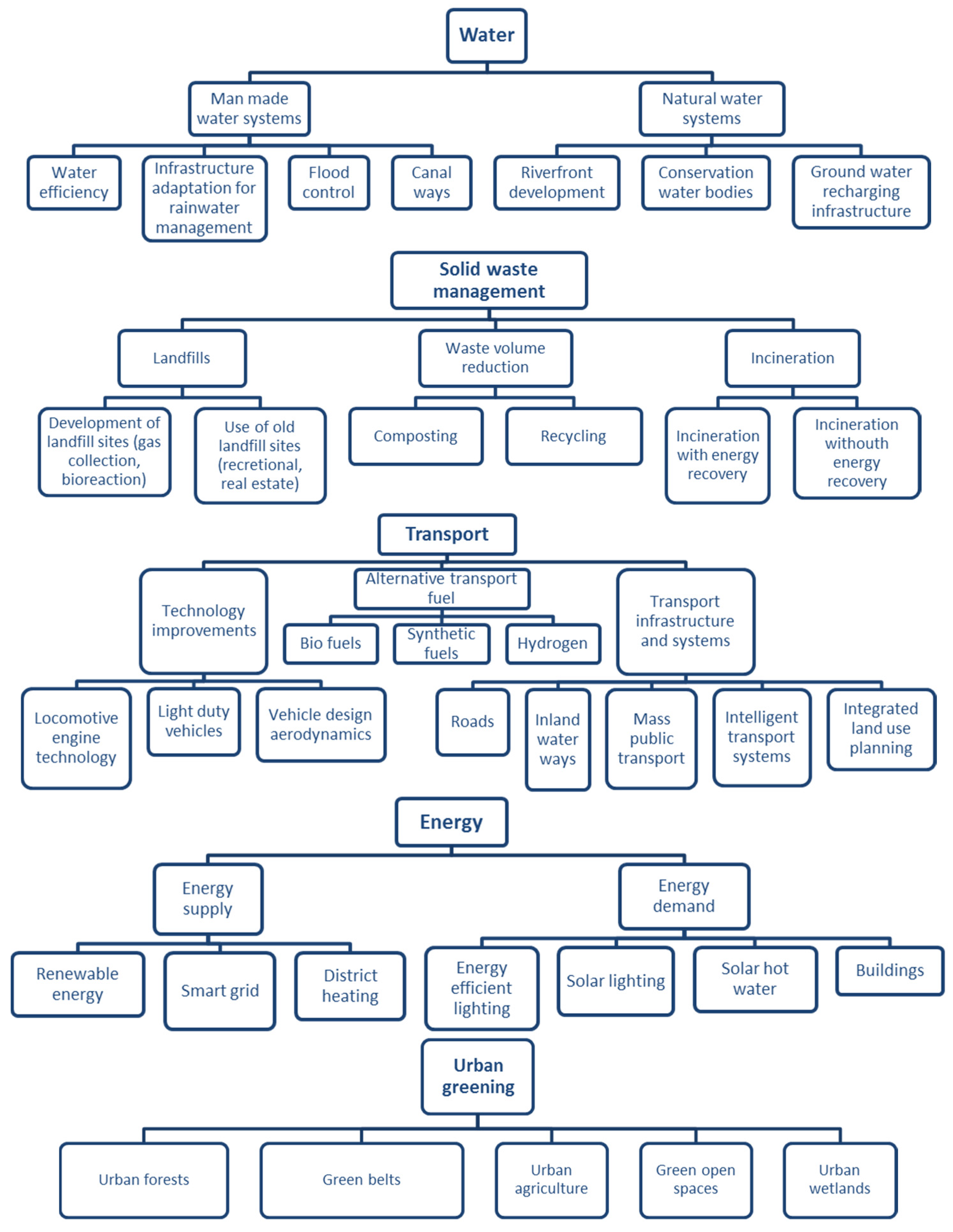
Appendix D: Scaling of Indicators for GIS Illustration
| Level of Performance | CO2 Capture (Percentage) | Scaling for GIS Process | Qualitative Evaluation |
|---|---|---|---|
| Very low | CO2 capture 0% to 5% | 0.00 | Very low level CO2 capture per area |
| Low | CO2 capture 5% to 10% | 0.25 | Low level CO2 capture per area |
| Acceptable | CrO2 capture 10% to 15% | 0.50 | Acceptable level CO2 capture per area |
| High | CO2 capture 15% to 20% | 0.75 | High level of CO2 capture per area |
| Very High | CO2 capture more than 20% | 1.0 | Very high CO2 capture per area |
| Level of Performance | Tree Cover (Trees per Inhabitant) | Scaling for GIS Process | Qualitative Evaluation |
|---|---|---|---|
| Very low | 1 tree per more than 12 inhabitants | 0.00 | Areas with very low cover in terms of trees per capita |
| Low | 1 tree per 6.1 to 12 inhabitants | 0.24 | Areas with low cover in terms of trees per capita |
| Acceptable | 1 tree per 4.1 to 6 inhabitants | 0.48 | Areas with medium cover in terms of trees per capita |
| High | 1 tree per 3.1 to 4 inhabitants | 0.72 | Areas with high cover in terms of trees per capita |
| Very High | 1 tree per 3 inhabitants | 1.00 | Areas with very high cover in terms of trees per capita |
References
- United Nations. World Economic and Social Survey 2013: Sustainable Development Challenges; United Nations: New York, NY, USA, 2013. [Google Scholar]
- Gross, R.; Heptonstall, P.; Blyth, W. Investment in Electricity Generation, the Role of Costs, Incentives and Risks; UK Energy Research Centre: London, UK, 2007. [Google Scholar]
- McGranahan, G. The Citizens at Risk; Earthscan: London, UK, 2001. [Google Scholar]
- Satterthwaite, D.; Bartlett, S.; Roberts, D.; Dodman, D.; Solecki, W.; Sverdlik, A.; Pelling, M. Chapter 13: Conclusions on ways forward. In Cities on a Finite Planet; Towards Transformative Responses to Climate Change; Bartlett, S., Satterthwaite, D., Eds.; Earthscan from Routledge: London, UK; New York, NY, USA, 2016; p. 243. [Google Scholar]
- Bangalore Outcome Document. Second Urban Sustainable Development Goal Campaign Consultation on Targets and Indicators, 2015. Available online: http://media.wix.com/ugd/bfe783_5f3512ca01df49c3b9d3c4e5a781926c.pdf (accessed on 12 February 2016).
- Newman, P.; Jennings, I. Cities as Sustainable Ecosystems: Principles and Practices; Island Press: Washington, DC, USA, 2008. [Google Scholar]
- Hoornweg, D.; Freire, M. Building Sustainability in an Urbanizing World; World Bank: Washington, DC, USA, 2013. [Google Scholar]
- Pisano, U. Resilience and Sustainable Development: Theory of Resilience, Systems Thinking and Adaptive Governance; European Sustainable Development Network (ESDN) Quarterly Report No. 26; ESDN: Vienna, Austria, 2012. [Google Scholar]
- Derissen, S.; Quaas, M.F.; Baumägrtner, S. The relationship between resilience and sustainability of ecological-economic systems. Ecol. Econ. 2011, 70, 1121–1128. [Google Scholar] [CrossRef]
- Redman, C.L. Should sustainability and resilience be combined or remain distinct pursuits? Ecol. Soc. 2014, 19, 37. [Google Scholar] [CrossRef]
- Brand, F.S.; Jax, K. Focusing the meaning(s) of resilience: Resilience as a descriptive concept and a boundary object. Ecol. Soc. 2007, 12, 23. [Google Scholar]
- Saunders, W.S.; Becker, J.S. A discussion of resilience and sustainability: Land use planning recovery from the Canterbury earthquake sequence, New Zealand. Int. J. Disaster Risk Reduct. 2015, 14, 73–81. [Google Scholar] [CrossRef]
- Tyler, S.; Moench, M. A framework for urban climate resilience, climate and development. Clim. Dev. 2012, 4, 311–326. [Google Scholar] [CrossRef]
- Folke, C.; Carpenter, S.R.; Walker, B.; Scheffer, M.; Chapin, T.; Rockström, J. Resilience Thinking: Integrating Resilience, Adaptability and Transformability. Ecol. Soc. 2010, 15, 20. [Google Scholar]
- Hunt, D.V.L.; Makana, L.O.; Jefferson, I.; Rogers, C.D.F. Liveable cities and urban underground space. Tunn. Undergr. Space Technol. 2016, 55, 8–20. [Google Scholar] [CrossRef]
- Shen, L.; Ochoa, J.J.; Shah, M.N.; Zhang, X. The application of urban sustainability indicators—A comparison between various practices. Habitat Int. 2011, 35, 17–29. [Google Scholar] [CrossRef]
- Chelleri, L.; Schuetze, T.; Salvati, L. Integrating resilience with urban sustainability in neglected neighborhoods: Challenges and opportunities of transitioning to decentralized water management in Mexico City. Habitat Int. 2015, 48, 122–130. [Google Scholar] [CrossRef]
- Matthews, E.C.; Sattler, M.; Friedland, C.J. A critical analysis of hazard resilience measures within sustainability assessment frameworks. Environ. Impact Assess. Rev. 2014, 48, 59–69. [Google Scholar] [CrossRef]
- World Bank. The World Bank Annual Report 2013; World Bank: Washington, DC, USA, 2013. [Google Scholar]
- Jha, A.K.; Miner, T.W.; Stanton-Geddes, Z. Building Urban Resilience. Principles, Tools, and Practice; World Bank: Washington, DC, USA, 2013. [Google Scholar]
- United Nations. UN Sustainable Development Solutions, 2013. Available online: http://unsdsn.org/ (accessed on 11 February 2016).
- World Bank. The World Bank Annual Report 2012; World Bank: Washington, DC, USA, 2012. [Google Scholar]
- Hammer, S.; Kamal-Chaoui, L.; Robert, A.; Plouin, M. Cities and Green Growth: A Conceptual Framework; Regional Development Working Papers 2011/08; OECD Publishing: Paris, France, 2011. [Google Scholar]
- Sharifi, A.; Murayama, A. A critical review of seven selected neighborhood sustainability assessment tools. Environ. Impact Assess. Rev. 2013, 38, 73–87. [Google Scholar] [CrossRef]
- Komeily, A.; Srinivasan, R.S. A need for balanced approach to neighborhood sustainability assessments: A critical review and analysis. Sustain. Cities Soc. 2015, 18, 32–43. [Google Scholar] [CrossRef]
- Charoenkit, S.; Kumar, S. Environmental sustainability assessment tools for low carbon and climate resilient low income housing settlements. Renew. Sustain. Energy Rev. 2014, 38, 509–525. [Google Scholar] [CrossRef]
- Environmental Protection Agency (EPA). Assessing the Multiple Benefits of Clean Energy; EPA: Washington, DC, USA, 2011.
- Victoria Transport Policy Institute. Well Measured—Developing Indicators for Sustainable and Livable Transport Planning; Victoria Transport Policy Institute: Victoria, BC, Canada, 2015. [Google Scholar]
- The United Nations Environment Programme. Integrated Waste Management Scoreboard—A Tool to Measure Performance in Municipal Solid Waste Management; UNEP: Nairobi, Kenya, 2013. [Google Scholar]
- Lundin, M. Indicators for Measuring the Sustainability of Urban Water Systems—A Life Cycle Approach. Ph.D. Thesis, Chalmers University of Technology, Göteborg, Sweden, 2003. [Google Scholar]
- Alberti, A. Measuring urban sustainability. Environ. Impact Assess. Rev. 1996, 16, 381–424. [Google Scholar] [CrossRef]
- Shen, Y.-C.; Lin, G.; Li, K.-P.; Yuan, B. An assessment of exploiting renewable energy sources with concerns of policy and technology. Energy Policy 2011, 38, 4604–4616. [Google Scholar] [CrossRef]
- Singh, R.K.; Murtya, H.R.; Guptab, S.K.; Dikshitb, A.K. An overview of sustainability assessment methodologies. Ecol. Indic. 2011, 9, 189–212. [Google Scholar] [CrossRef]
- Science for Environment Policy. In-Depth Report: Indicators for Sustainable Cities. Available online: http://ec.europa.eu/environment/integration/research/newsalert/pdf/indicators_for_sustainable_cities_IR12_en.pdf (accessed on 9 May 2016).
- Kijak, R.; Moy, D. Decision Support Framework For Sustainable Waste Managemen. J. Ind. Ecol. 2004, 8, 33–50. [Google Scholar] [CrossRef]
- Sembiring, E.; Nitivattananon, V. Sustainable Solid Waste Management toward an Inclusive Society: Integration of the Informal Sector. Resour. Conserv. Recycl. 2010, 54, 802–809. [Google Scholar] [CrossRef]
- Belton, V.; Stewart, T. Multiple Criteria Decision Analysis: An Integrated Approach; Kluwer Academic Publishers: Boston, MA, USA, 2002. [Google Scholar]
- Grafakos, S.; Flamos, A.; Zevgolis, D.; Oikonomou, V. Multi Criteria Analysis weighting methodology to incorporate stakeholders’ preferences in energy and climate policy interactions. Int. J. Energy Sect. Manag. 2010, 4, 434–461. [Google Scholar]
- Haque, A.; Grafakos, S.; Huijsman, M. Assessment of adaptation measures against flooding in the city of Dhaka, Bangladesh. Environ. Urban. 2011, 24, 17. [Google Scholar]
- Nguyen, B.; Atlan, H. Comparative review of five sustainable rating systems. Procedia Eng. 2011, 21, 376–386. [Google Scholar] [CrossRef]
- Institute for Sustainable Infrastructure. Envision: A Rating System for Sustainable Infrastructure; Institute for Sustainable Infrastructure: Washington, DC, USA, 2012. [Google Scholar]
- Sutter, C.; Parreño, J.C. Does the current Clean Development Mechanism (CDM) deliver its sustainable development claim? An analysis of officially registered CDM projects. Clim. Change 2007, 84, 75–90. [Google Scholar] [CrossRef]
- Olsen, K.; Fenhann, J. Sustainable Development Benefits of Clean Development Mechanism Projects. A new methodology for sustainability assessment based on text analysis of the project design documents submitted for validation. Energy Policy 2008, 36, 2819–2830. [Google Scholar] [CrossRef]
- Nussbaumer, P. On the contribution of labelled Certified Emission Reductions to sustainable development: A multi-criteria evaluation of CDM projects. Energy Policy 2009, 37, 91–101. [Google Scholar] [CrossRef]
- Drupp, M.A. Does the Gold Standard label hold its promise in delivering higher Sustainable Development benefits? A multi-criteria comparison of CDM projects. Energy Policy 2011, 39, 1213–1227. [Google Scholar] [CrossRef]
- The Climate, Community & Biodiversity Alliance. Climate, Community & Biodiversity Project Design Standards Second Editio; CCBA: Arlington, VA, USA, 2008. [Google Scholar]
- Morrison-Saunders, A.; Pope, J.; Bond, A.; Retief, F. Towards sustainability assessment follow-up. Environ. Impact Assess. Rev. 2014, 45, 38–45. [Google Scholar] [CrossRef]
- Reed, R.; Bilos, A.; Wilkinson, S.; Schulte, K. International comparison of sustainable rating tools. J. Sustain. Real Estate 2009, 1, 1–22. [Google Scholar]
- Pope, J.; Annandale, D.; Morrison-Saunders, A. Conceptualising sustainability assessment. Environ. Impact Assess. Rev. 2004, 24, 595–616. [Google Scholar] [CrossRef]
- Olhoff, A.; Markandya, A.; Halsnaes, K.; Taylor, T. CDM. In Sustainable Development Impacts; UNEP: Nairobi, Kenya, 2010. [Google Scholar]
- United Nations Environment Programme. UNEP Year Book 2011; United Nations Environment Programme: Nairobi, Kenya, 2011. [Google Scholar]
- Cash, D.W.; Adger, W.; Berkes, F.; Garden, P.; Lebel, L.; Olsson, P.; Pritchard, L.; Young, O. Scale and cross-scale dynamics: Governance and information in a multilevel world. Ecol. Soc. 2006, 11, 8. [Google Scholar]
- International Energy Agency. Spreading the Net: The Multiple Benefits of Energy Efficiency Improvements; IEA: Paris, France, 2012. [Google Scholar]
- Grafakos, S.; Enseñado, E.M.; Flamos, A.; Rotmans, J. Mapping and Measuring European Local Governments’ Priorities for a Sustainable and Low-Carbon Energy Future. Energies 2015, 8, 11641–11666. [Google Scholar] [CrossRef]
- Rotmans, J. Tools for Integrated Sustainability Assessment: A two track approach. Integr. Assess. J. 2006, 6, 35–57. [Google Scholar]
- Sinclair, A.J.; Diduck, A.; Fitzpatrick, P. Conceptualizing learning for sustainability through environmental assessment: critical reflections on 15 years of research. Environ. Impact Assess. Rev. 2008, 28, 415–428. [Google Scholar] [CrossRef]
- Neuenschwander, N.; Hayek, U.W.; Grêt-regamey, A. Integrated Multi-Criteria Modeling and 3D Visualization for Informed Trade-Off Decision Making on Urban Development Options. In Proceedings of the 30th International Conference on Education and research in Computer Aided Architectural Design in Europe (eCAADe 2012), Prague, Czech Republic, 12–14 September 2012.
- Mori, K.; Fujii, T.; Yamashita, T.; Mimura, Y.; Uchiyama, Y.; Hayashi, K. Visualization of a City Sustainability Index (CSI): Towards Transdisciplinary Approaches Involving Multiple Stakeholders. Sustainability 2015, 7, 12402–12424. [Google Scholar] [CrossRef] [Green Version]
- Organisation for Economic Co-operation and Development. OECD Environmental Performance Reviews; OECD: Paris, France, 2010. [Google Scholar]
- Organisation for Economic Co-operation and Development. OECD Environmental Indicators 2005; OECD: Paris, France, 2005. [Google Scholar]
- Reid, W.V.; Sarukhán, J.; Whyte, A. Millennium Ecosystem Assessment Synthesis Report; Island Press: Washington, DC, USA, 2005. [Google Scholar]
- Wolman, A. The metabolism of cities. Sci. Am. 1965, 213, 179–190. [Google Scholar] [CrossRef] [PubMed]
- Newman, P. Sustainability and cities: Extending the metabolism model. Landsc. Urban Plan. 1999, 44, 219–226. [Google Scholar] [CrossRef]
- Ravetz, J. Integrated Assessment for Sustainability Appraisal in Cities and Regions. Environ. Impact Assess. Rev. 2000, 20, 31–64. [Google Scholar] [CrossRef]
- Resilience Alliance. Urban Resilience. Research Prospectus. A Resilience Alliance Initiative for Transitioning Urban Systems towards Sustainable Futures. Available online: http://www.citiesforpeople.ca/wp-content/uploads/2014/02/urbanresilienceresearchprospectusv7feb07.pdf (accessed on 3 May 2016).
- Fiksel, J.; Eason, T.; Frederickson, H. A Framework for Sustainability Indicators at EPA; United States Environmental Protection Agency: Washington, DC, USA, 2012. [Google Scholar]
- Bierbaum, R.; Stocking, M.; Bouwman, H.; Cowie, A. Delivering Global Environmental Benefits for Sustainable Development; Report of the Scientific and Technical Advisory Panel (STAP) to the 5th GEF Assembly, México; Global Environment Facility: Washington, DC, USA, 2014. [Google Scholar]
- Eakin, H.C.; Lemos, M.C.; Nelson, D.R. Differentiating capacities as a means to sustainable climate change adaptation. Glob. Environ. Change 2014, 27, 1–8. [Google Scholar] [CrossRef]
- Clarvis, M.H.; Allan, A. Adaptive capacity in a chilean context: A questionable model for latin america. Environ. Sci. Policy 2014, 43, 78–90. [Google Scholar] [CrossRef]
- D’Acci, L. Monetary, Subjective and Quantitative Approaches to Assess Urban Quality of Life and Pleasantness in Cities (Hedonic Price, Willingness-to-Pay, Positional Value, Life Satisfaction, Isobenefit Lines). Soc. Indic. Res. 2014, 115, 531–559. [Google Scholar] [CrossRef]

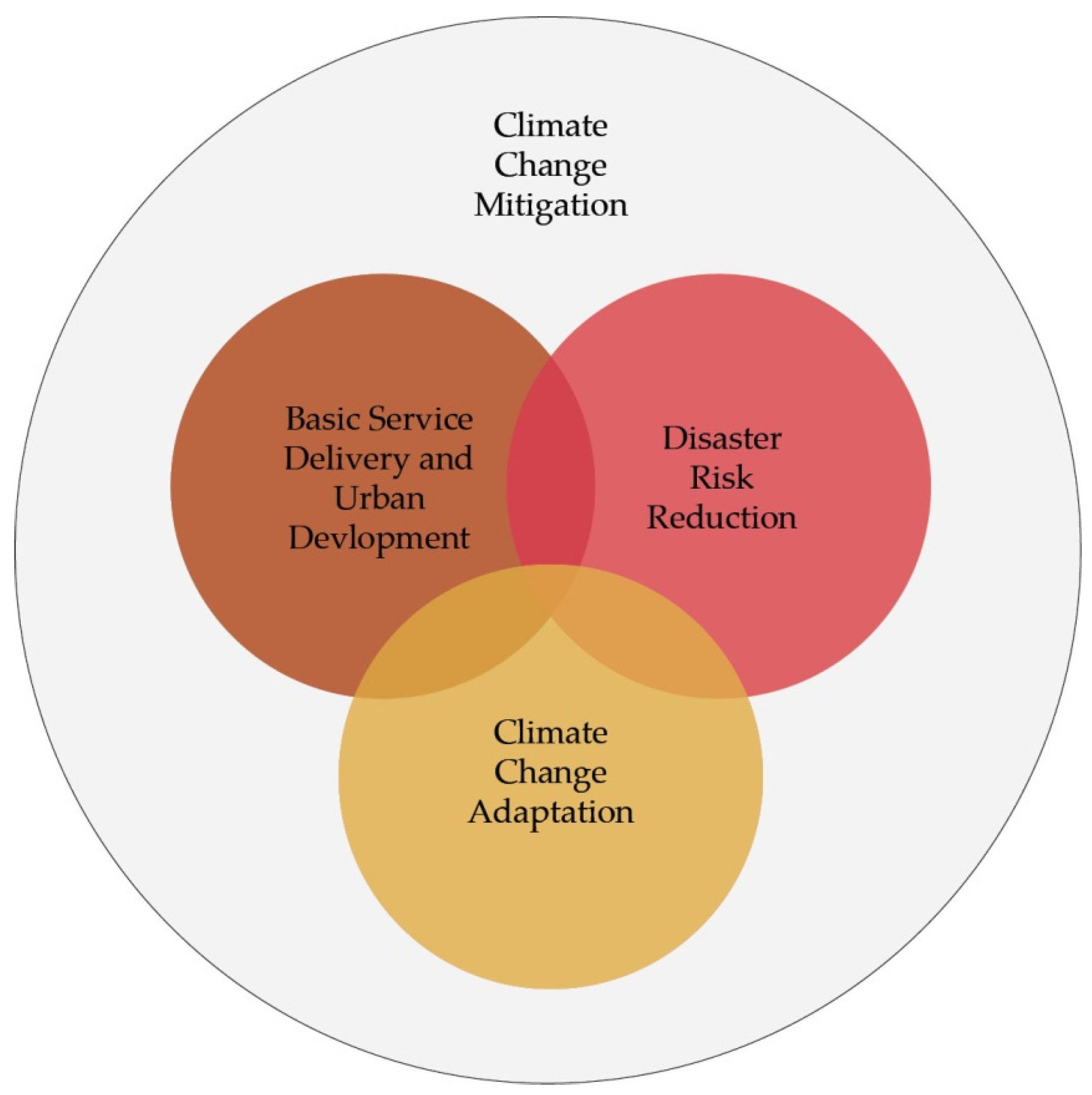
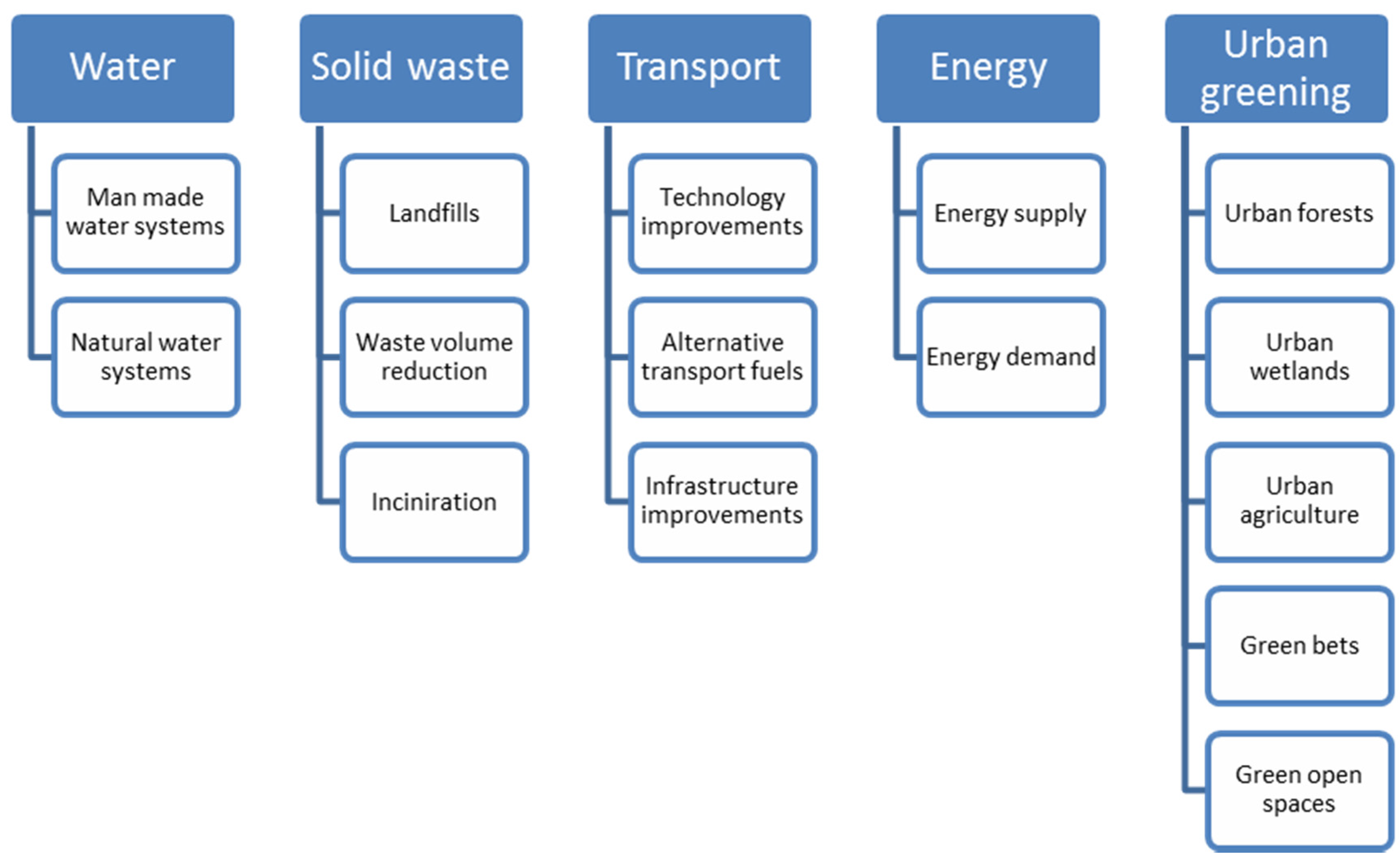
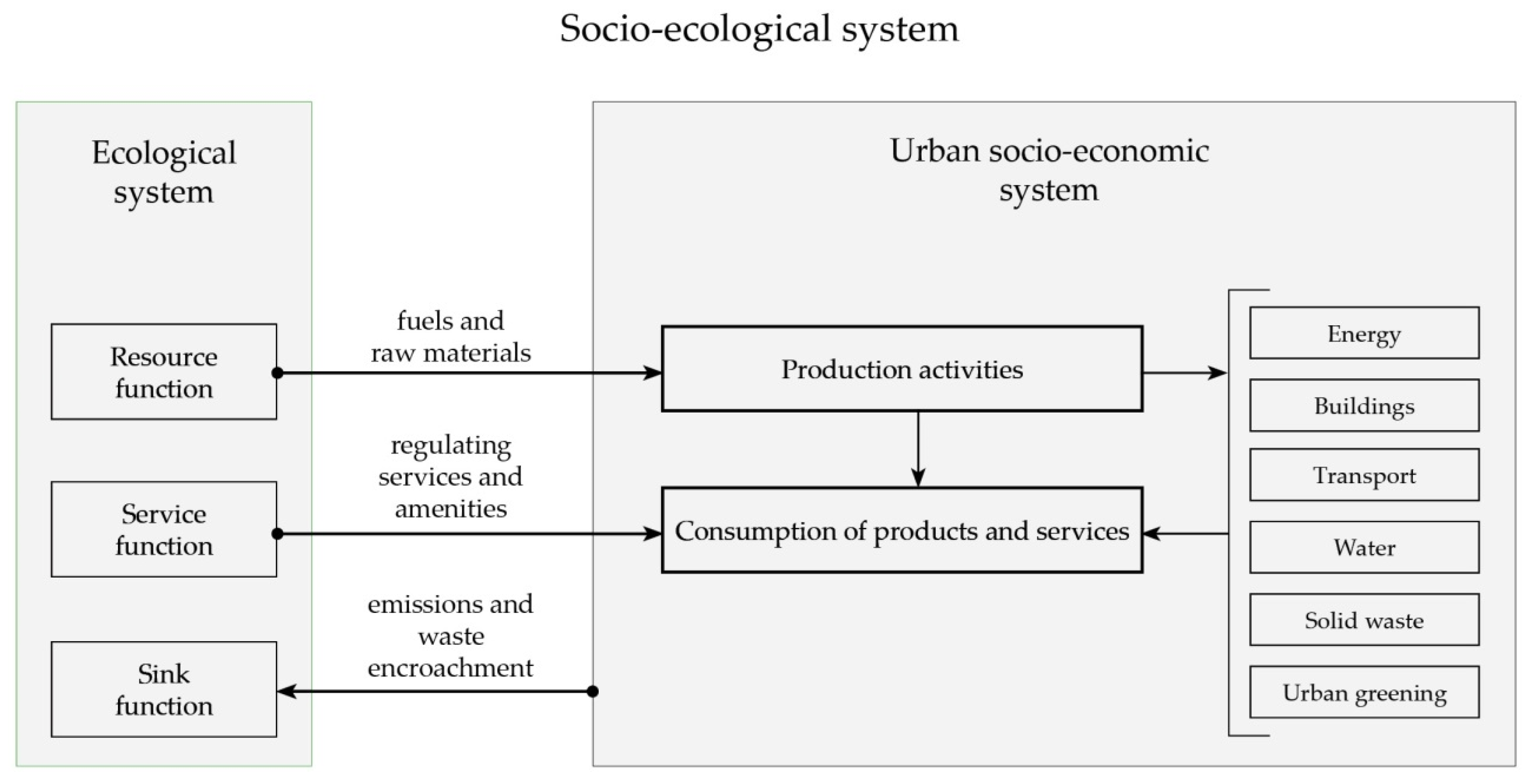
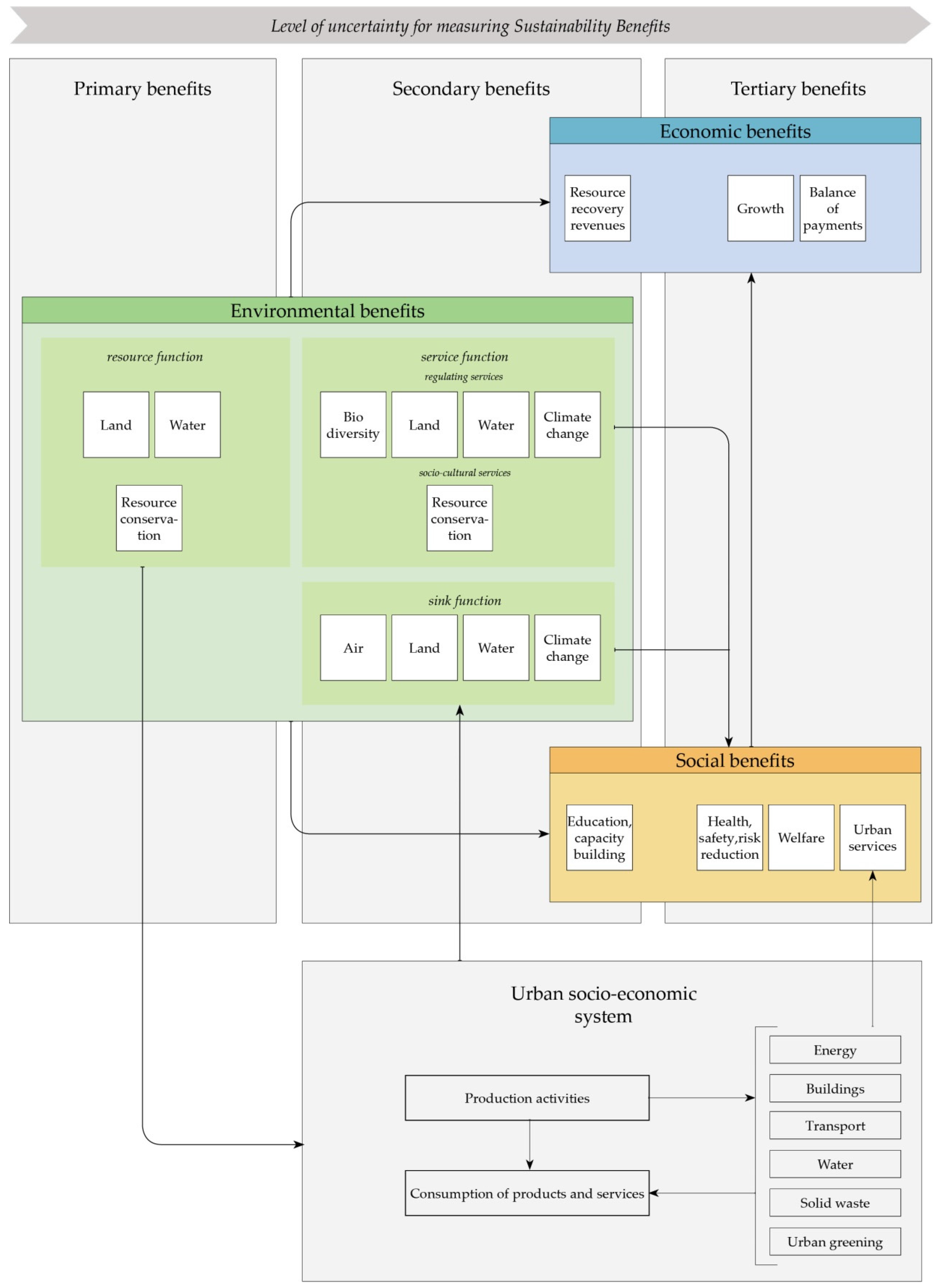
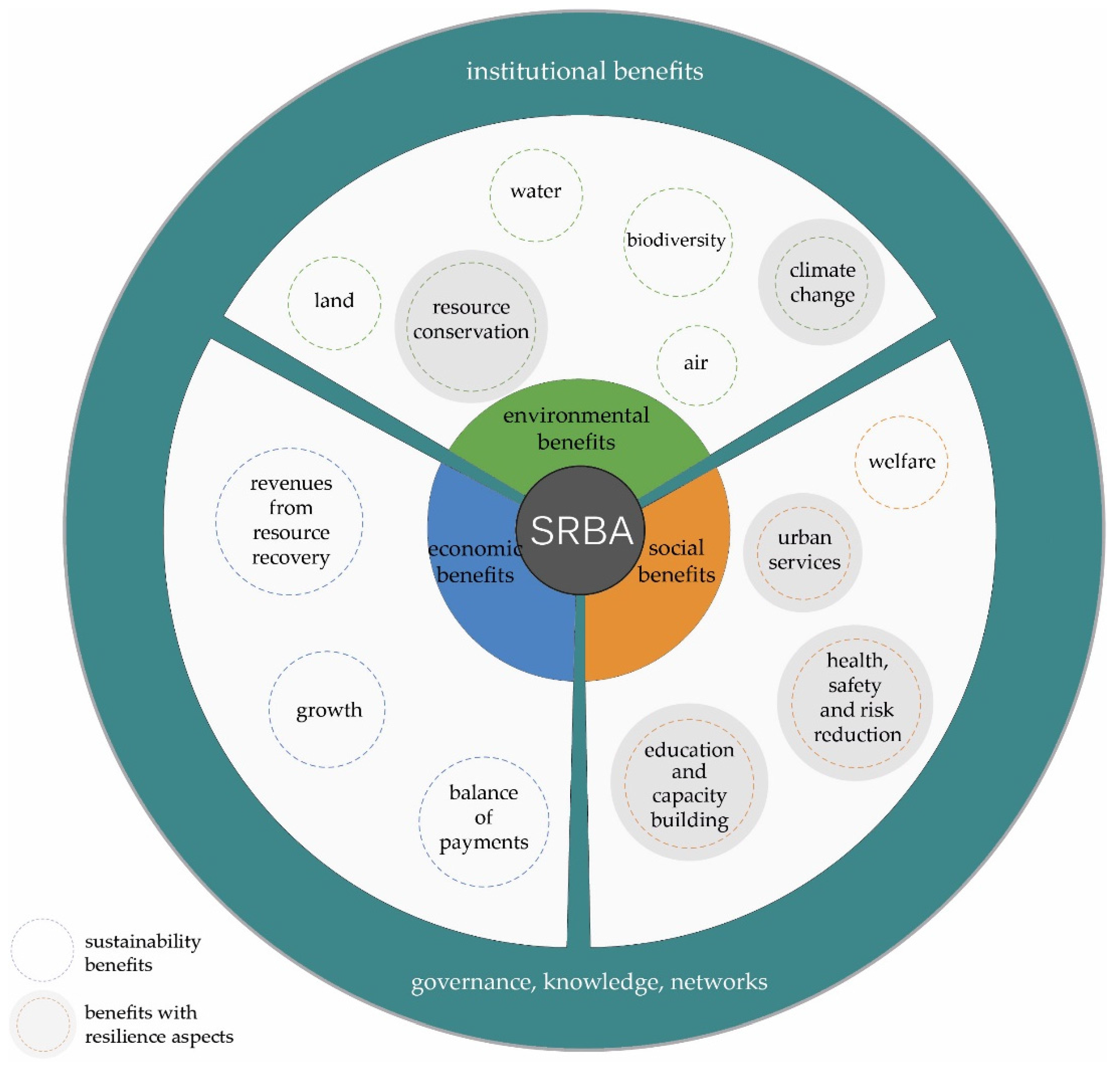
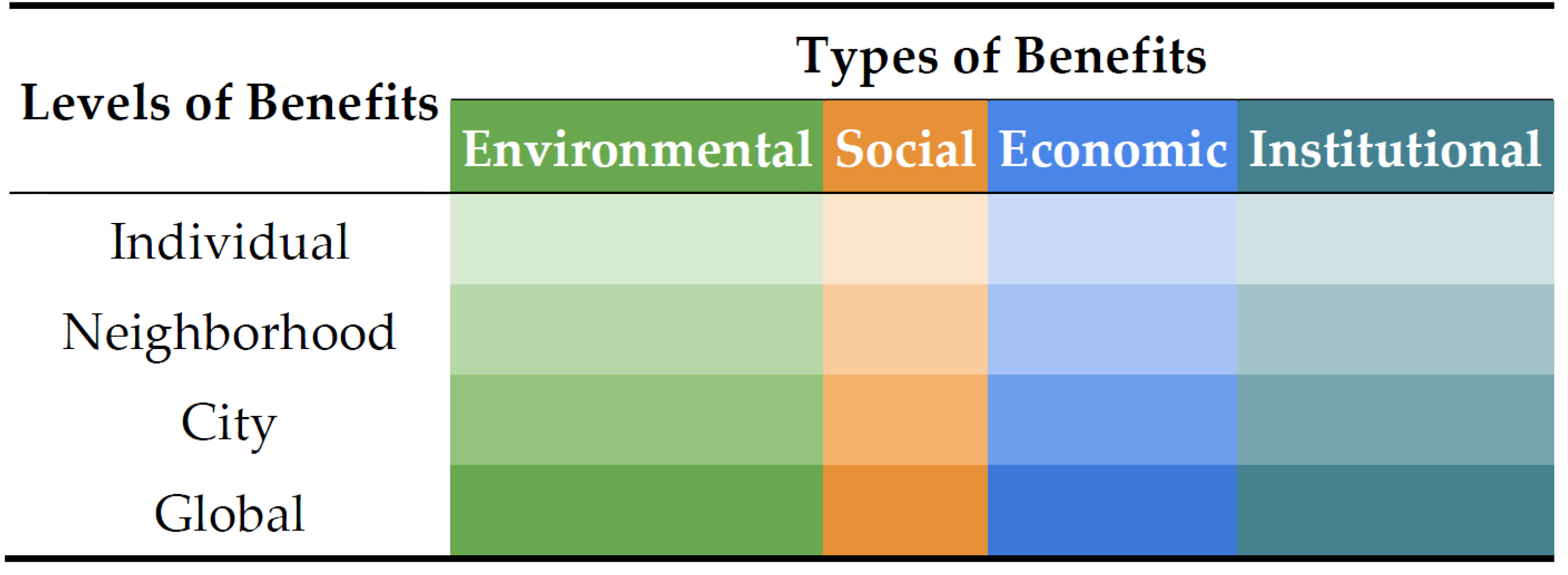
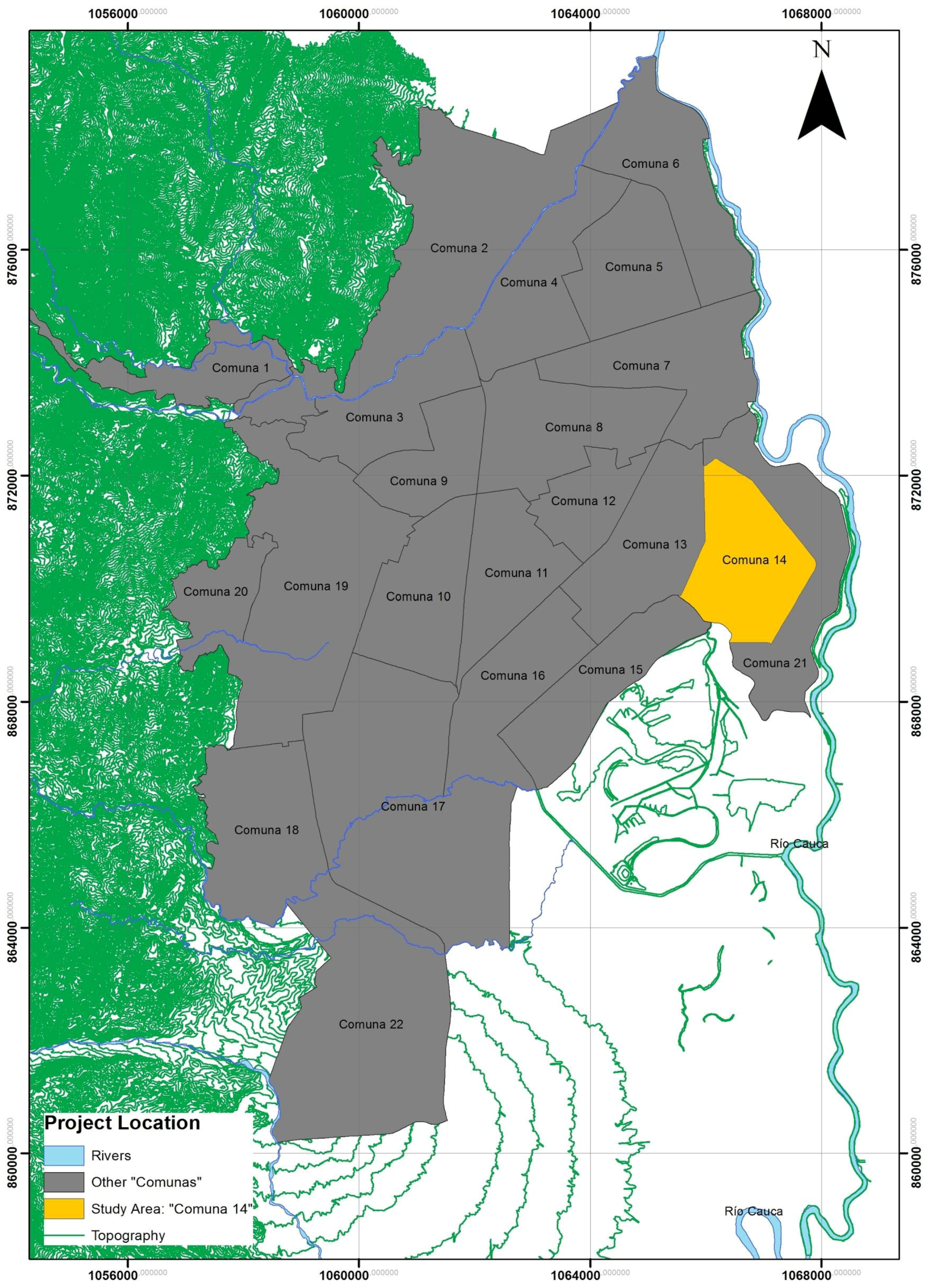
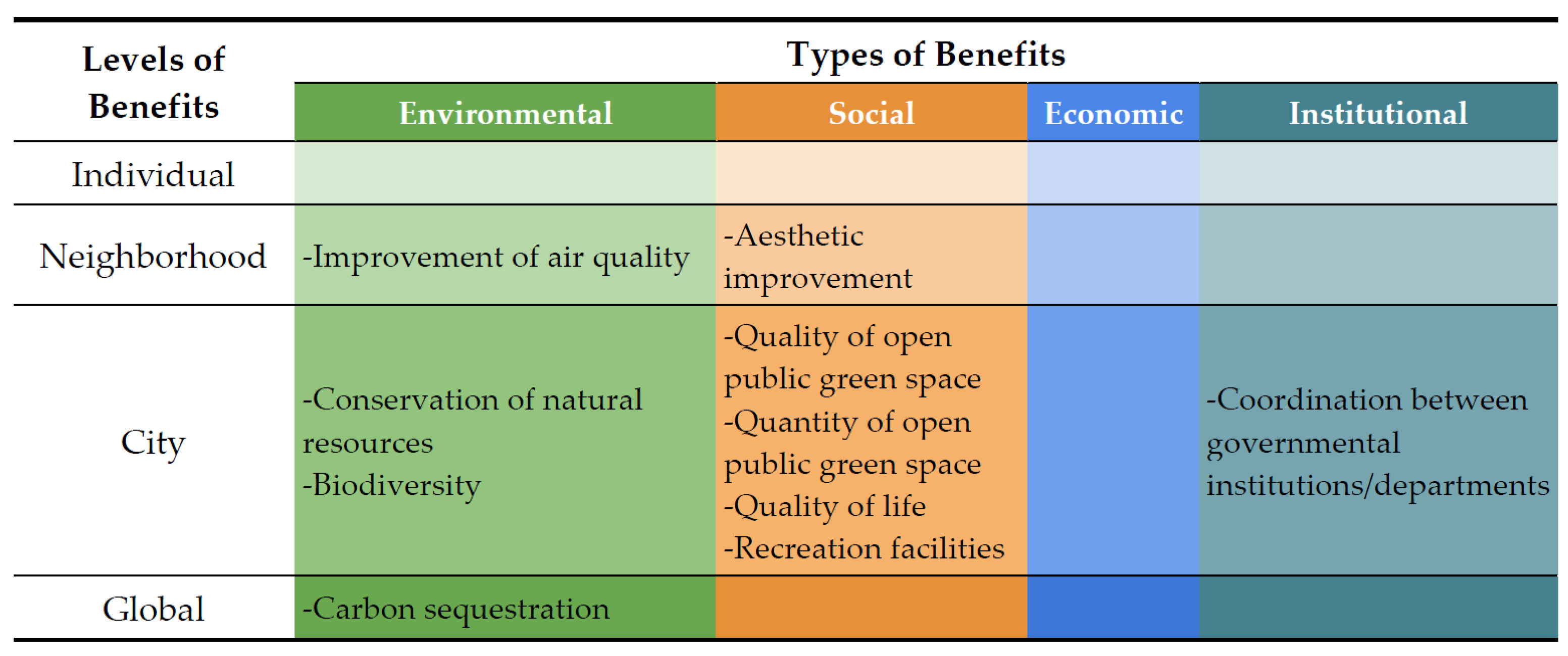
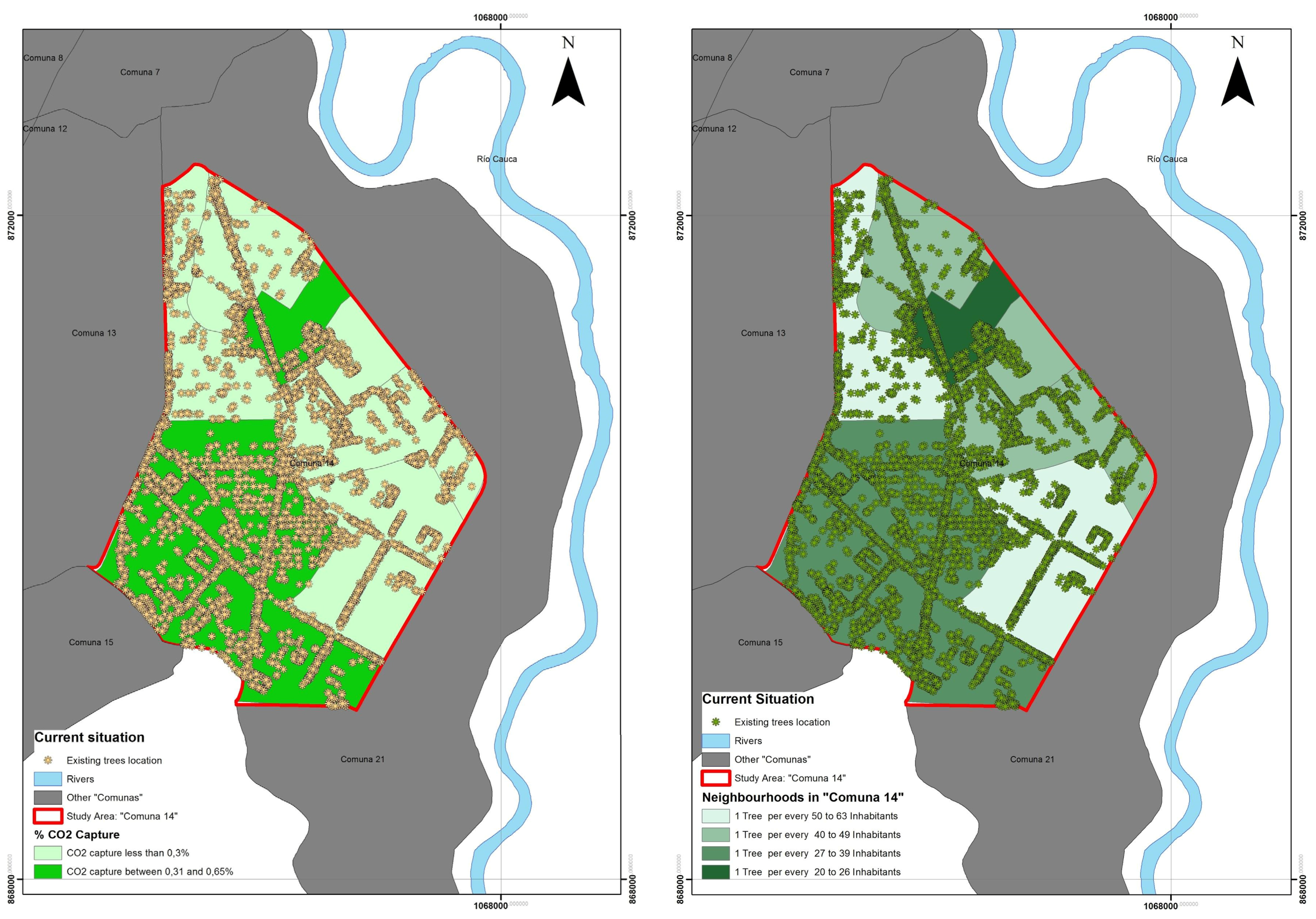
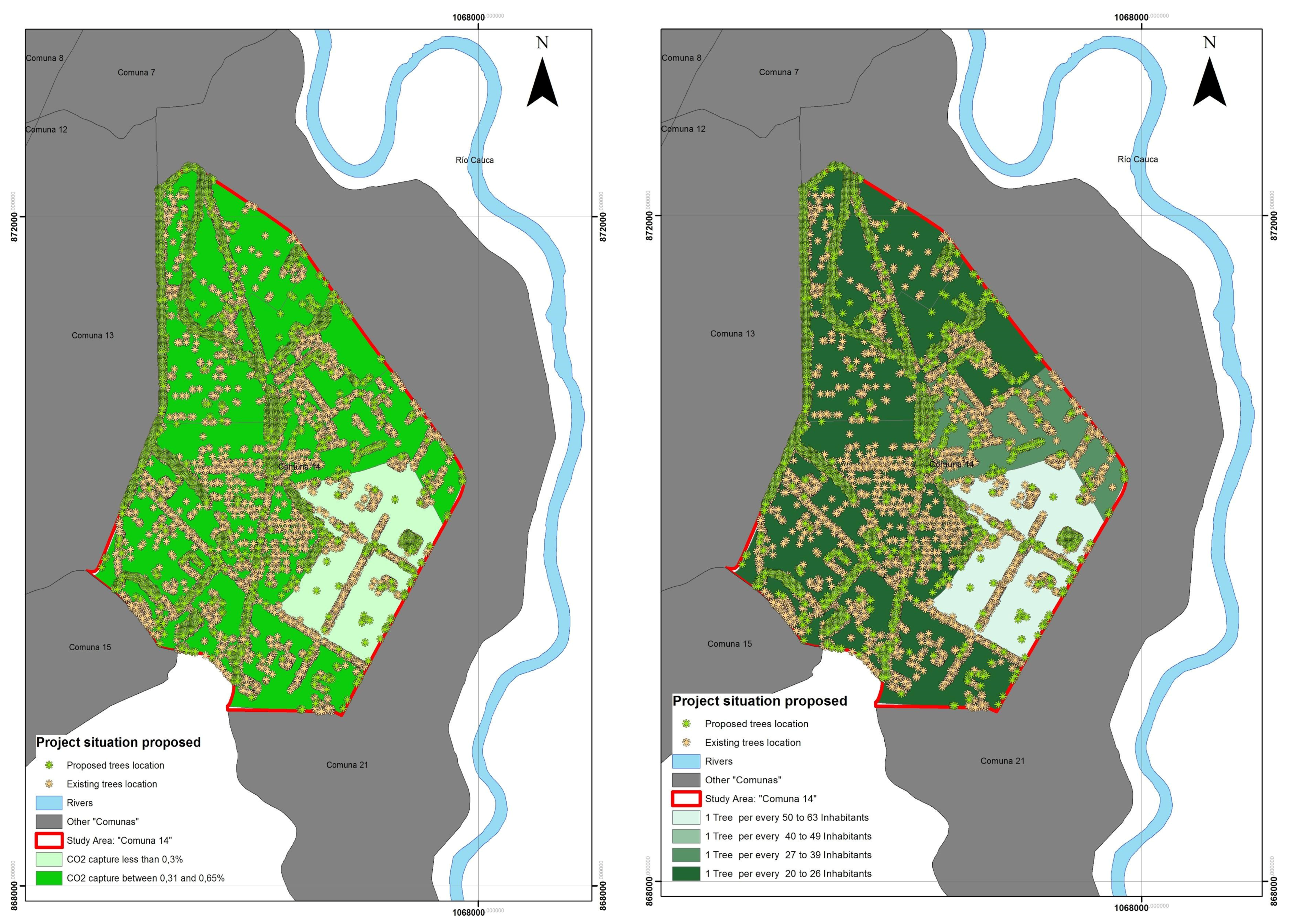

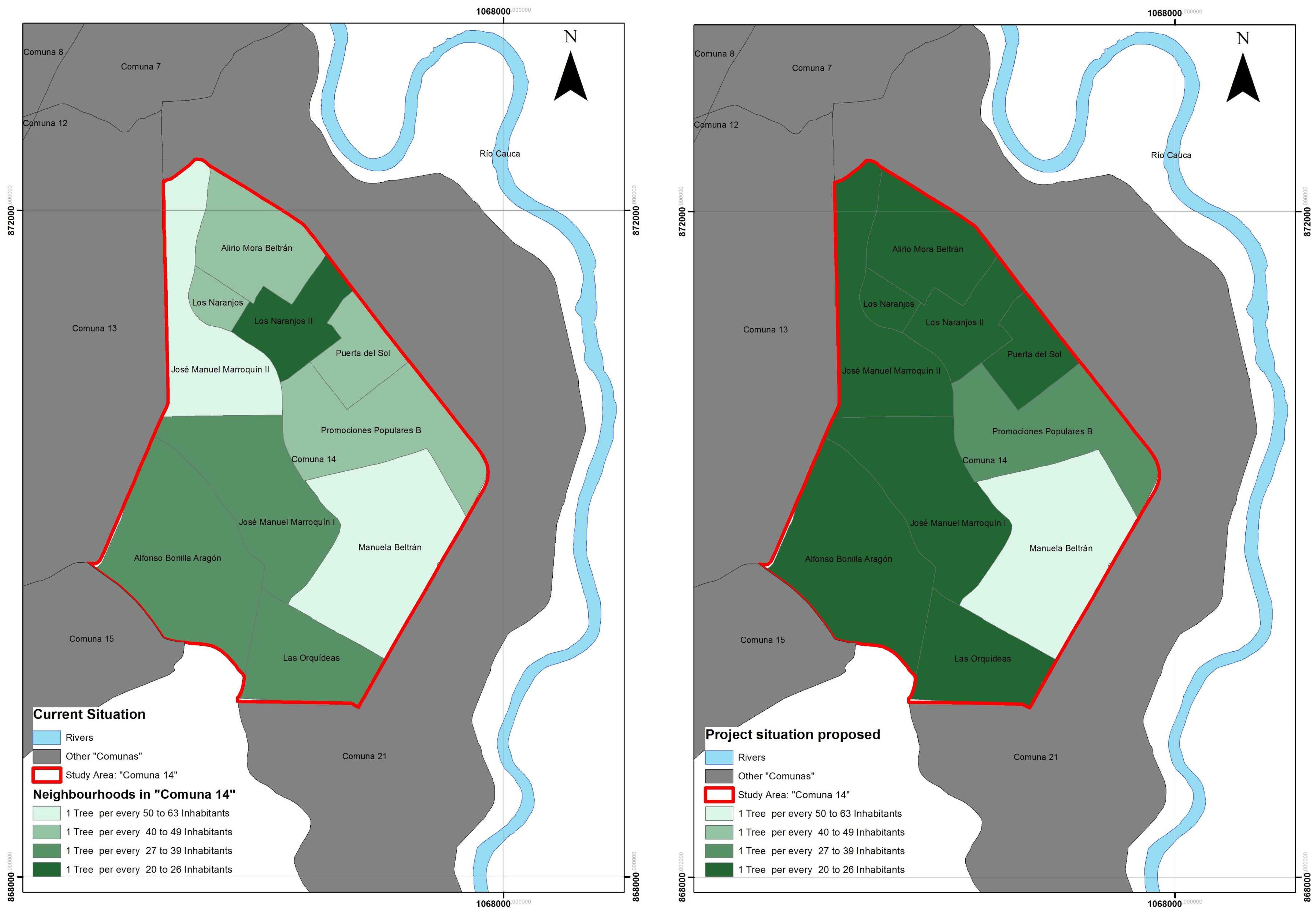
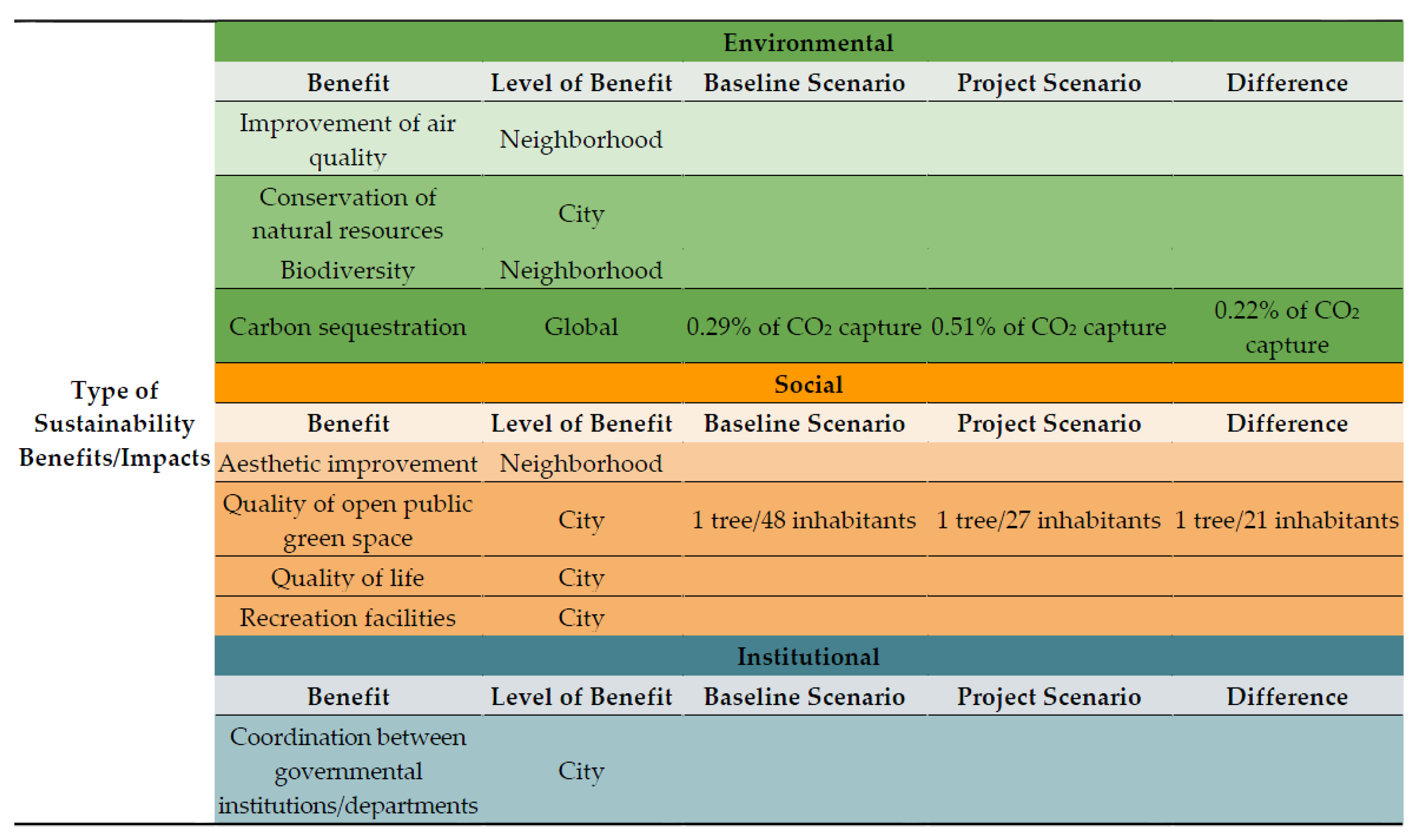
| Resource Function | Through the resource function, the ecological system provides renewable and non-renewable resources, raw materials, fuels, minerals and fibers, which are used as inputs for production activities. Production activities through industrial processes transform these inputs into products and services to human societies. However, production processes and consumption of products lead ultimately to emissions and waste flows back to the environment. |
| Sink Function | The sink function of the ecological systems is the capacity of the environment to absorb the unwanted by-products of production and consumption, emissions from combustion or chemical processing, etc. (OECD, 2005 [60]). However, air pollutants and waste in large amounts often challenge nature’s capacity to absorb and process them, leading to contamination of natural resources (air, soil and water). Consequently, environmental contamination and pollution often lead to impacts to human welfare, such as polluted air and water, affecting human health and welfare directly |
| Service Function | The service function of the ecological system refers to the (i) regulating and (ii) socio-cultural (amenity) services that nature provides to human beings. According to the Millennium Ecosystem Assessment (2005) [61], regulating services (or life-supporting services) are services that provide benefits to human societies from the control of natural processes by ecosystems, such as flood control, micro-climate regulation, carbon sequestration, water purification, etc., and are intensely linked with the main constituents of human well-being (e.g., security, health). Furthermore, socio-cultural (amenity) services are the non-material benefits ecosystems provide to humans for socio-cultural and recreational activities. |
© 2016 by the authors; licensee MDPI, Basel, Switzerland. This article is an open access article distributed under the terms and conditions of the Creative Commons Attribution (CC-BY) license (http://creativecommons.org/licenses/by/4.0/).
Share and Cite
Grafakos, S.; Gianoli, A.; Tsatsou, A. Towards the Development of an Integrated Sustainability and Resilience Benefits Assessment Framework of Urban Green Growth Interventions. Sustainability 2016, 8, 461. https://doi.org/10.3390/su8050461
Grafakos S, Gianoli A, Tsatsou A. Towards the Development of an Integrated Sustainability and Resilience Benefits Assessment Framework of Urban Green Growth Interventions. Sustainability. 2016; 8(5):461. https://doi.org/10.3390/su8050461
Chicago/Turabian StyleGrafakos, Stelios, Alberto Gianoli, and Alexandra Tsatsou. 2016. "Towards the Development of an Integrated Sustainability and Resilience Benefits Assessment Framework of Urban Green Growth Interventions" Sustainability 8, no. 5: 461. https://doi.org/10.3390/su8050461





